Art World
Are These 11 American Art Landscapes Worth Saving?
The Frick's garden, Watts Tower, and the Bay Lights are among the at risk sites.
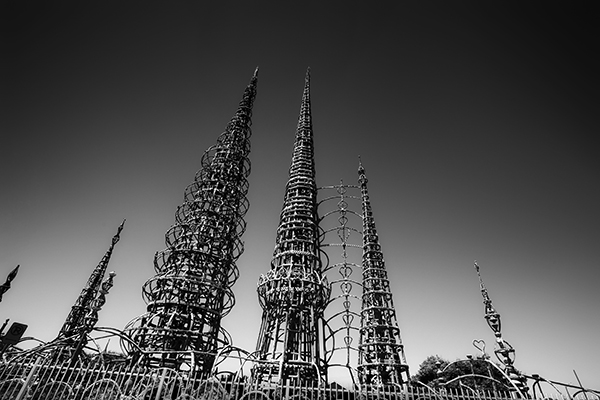
The Frick's garden, Watts Tower, and the Bay Lights are among the at risk sites.

Sarah Cascone

The annual Landslide, the Cultural Landscape Foundation‘s list of threatened or at-risk land-based art sites, was announced yesterday. The group of art landscapes and landscape features currently threatened by neglect, poor maintenance, lack of funding, and even vandalism and demolition range from ancient rock carvings and folk art to environmental projects and contemporary light installations.
The eleven sites selected for 2014, listed below, were chosen from over 100 submissions. The plights of over 200 culturally-significant properties have been publicized by Landslide since it was first issued in 2003.
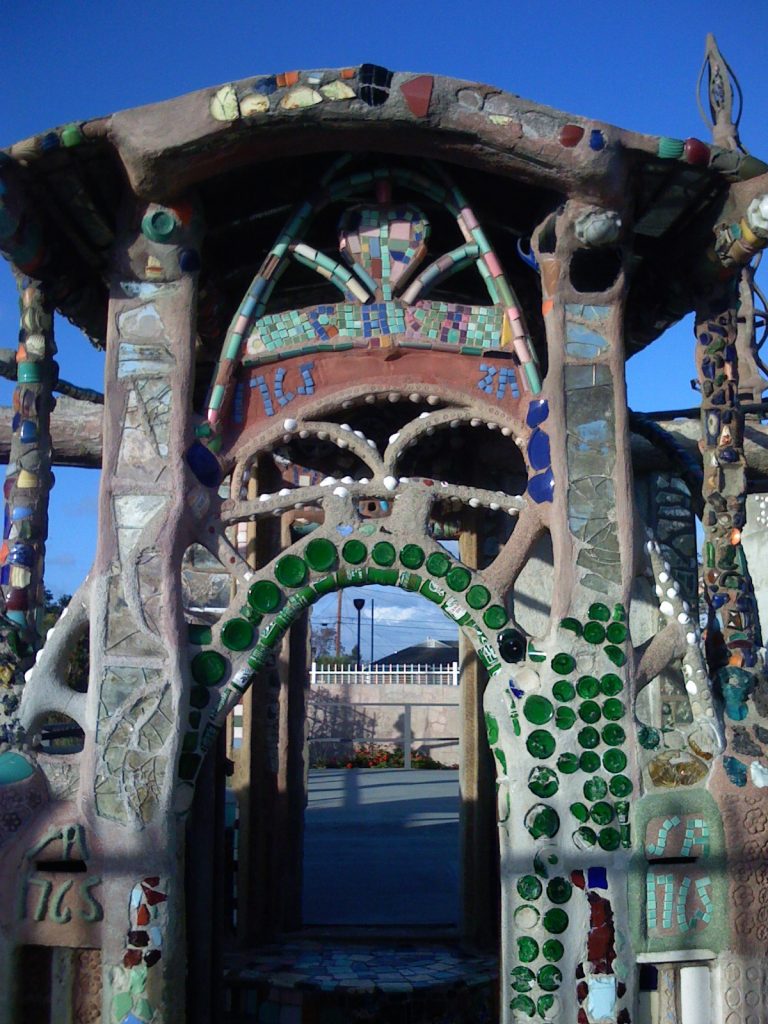
Entrance archway detail of the Watts Towers in Los Angeles, California, showing the decorative use of pottery shards, tile fragments, broken bottles, broken window glass, and seashells. Photo by JamesMadison, public domain.
Watts Towers, Simon Rodia, Los Angeles
Watts Towers, one of artnet New’s favorite art pilgrimages (see “10 Exotic Art Pilgrimages to Take, to Dream of, for Summer“), is a group of seventeen sculptures built by Southern Italian immigrant Sabato Rodia between 1921 and 1954. Two of the steel reinforced towers, made from cement stucco and decorated with shells, glass, and tiles, approach 100 feet tall. Rodia bent steel by hand, secured it with wire, wrapped it with mesh, and covered it with cement and decorative materials, all without the assistance of machines, welding, or bolts. Now a part of the Simon Rodia State Historic Park, and a National Historic Landmark, Watts Towers needs proper maintenance. Though Los Angeles’s Department of Cultural Affairs has teamed with the Los Angeles County Museum of Art to develop a conservation plan, city funds have not yet been officially designated for the Towers.
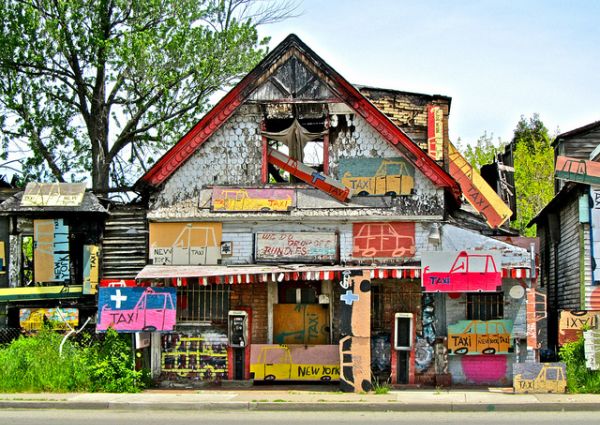
The Heidelberg Project, Detroit. Photo: Ellenm1, via Flickr.
The Heidelberg Project, Tyree Guyton, Detroit
The damage to Detroit’s Heidelberg Project, a stretch of abandoned homes transformed into art installations by Tyree Guyton beginning in 1986, has been well-documented. The city demolished part of the project twice in the 1990s, and arsonists destroyed several properties in 2013 and 2014. In a part of Detroit particularly hard-hit by urban decay, Guyton revitalized a vacant neighborhood, painting the sidewalks and streets, and turning the properties into themed installations, covering buildings, cars, and trees with discarded everyday objects such as of shoes, clocks, bicycles, and stuffed animals. Despite the damage, fundraising efforts are looking to repair and maintain the site, which they hope will gain site official recognition from the city.
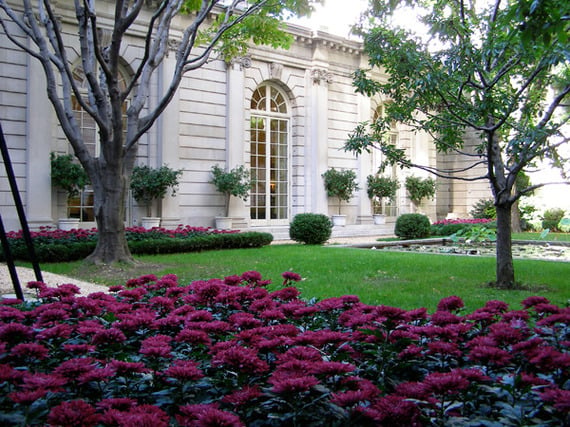
The Frick Collection Russell Page garden. Photo: Henk van der Eijk, via Flickr.
70th Street Garden, the Frick Collection, Russell Page, New York
As New York’s Frick Collection announced plans to expand earlier this year (see “Will Massive Expansion Destroy Beloved Frick Museum?“), the institution downplayed one museum asset that would fall victim to the construction: influential British landscape architect Russell Page’s garden on East 70th Street. In defending their decision, Frick officials claimed the garden was only ever temporary, and that it was closed to the public. Research from the Cultural Landscape Foundation president Charles A. Birnbaum revealed that it was actually conceived as a permanent addition to the museum after the 1977 abandonment of an earlier expansion plan (see “Frick Garden Was Meant to Be Permanent“). As a viewing garden, the space was designed to be seen from the street and the museum. The museum cannot demolish Page’s only remaining New York city work without the approval of New York’s Landmarks Preservation Commission.
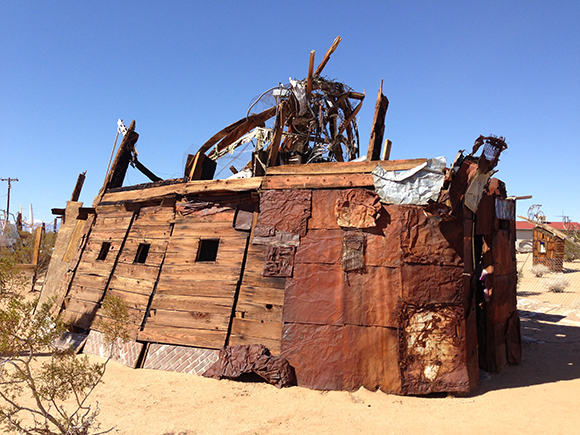
Noah Purifoy Outdoor Desert Art Museum of Assemblage Sculpture. Photo: Juan Devis, courtesy Boom Magazine.
Noah Purifoy Outdoor Desert Art Museum of Assemblage Sculpture, Noah Purifoy, Joshua Tree, California
Located in foothills of the Mojave Desert, near the Mojave National Preserve, the Noah Purifoy Outdoor Desert Art Museum of Assemblage Sculpture includes the home, studio, and sculpture park of assemblage artist Noah Purifoy. Between 1989 and his death in 2004, Purifoy filled the site with 120 of his artworks. His sculptures and installations, made from unconventional materials such as tires, bowling balls, railroad ties, vacuum cleaners, charred wood, and old car parts, have degraded over the years from constant exposure to the elements, and are in need of maintenance.
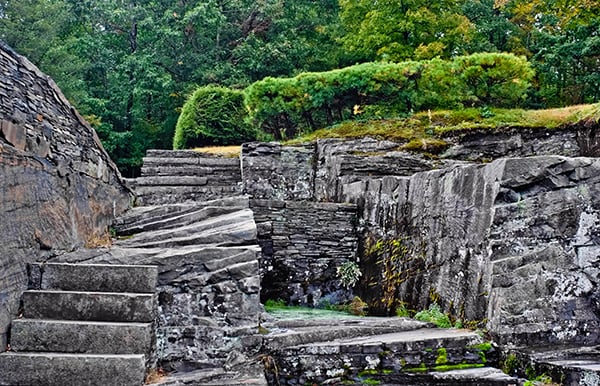
Harvey Fite, Opus 40, Saugerties, New York. Photo: Thomas H. Hahn, courtesy the Cultural Landscape Foundation.
Opus 40, Harvey Fite, Saugerties, New York
A monumental abstract work, Opus 40 was created by primarily self-taught artist Harvey Fite at his home in the Catskill Mountains between 1939 and his death in 1976. Utilizing rubble sourced from a nearby abandoned bluestone quarry, Fite used the traditional dry key stone masonry technique, eschewing mortar. In 2011 and 2012, portions of the work were damaged by Hurricanes Irene (2011) and Sandy (2012), leading to the eventual collapse of one of the oldest sections, a 14-foot high wall. As a result, repairs and maintenance are badly needed.

Wells Petroglyph Preserve. Photo: PEEC Nature Center, via Flickr.
Wells Petroglyph Preserve, Archaic and Ancestral Puebloans, New Mexico
The ancient petroglyph rock art at the Wells Petroglyph Preserve in northern New Mexico’s Mesa Prieta include some 8,000–10,000 images created over a 7,500-year period. Mesa Prieta is part of El Camino Real de Tierra Adentro National Historic Trail. A multi-year drought in the region has worsened erosion at the site, and the Mesa Prieta Petroglyph Project, despite its best efforts, is struggling to stabilize recent damage.
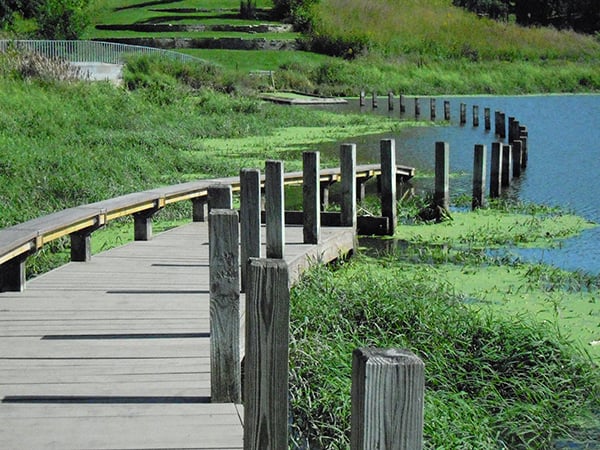
Mary Miss, Greenwood Pond: Double Site, Des Moines. Photo: Judith Eastburn, courtesy the Cultural Landscape Foundation.
Greenwood Pond: Double Site, Mary Miss, Des Moines
Environmentally engaged artist Mary Miss’s Greenwood Pond: Double Site (1989–96), commissioned by the Des Moines Art Center, is one of only eight of her permanent landscape works still in existence. Considered the country’s “first urban wetland project,” Double Site allows visitors to experience Greenwood Pond in new ways, interacting with the site from unexpected vantage points along walkways and from lookout platforms and pavilions. Over the years, the wooden structures have been worn down by the weather and vandalism, and the piece is in need of funding for much-needed restoration.
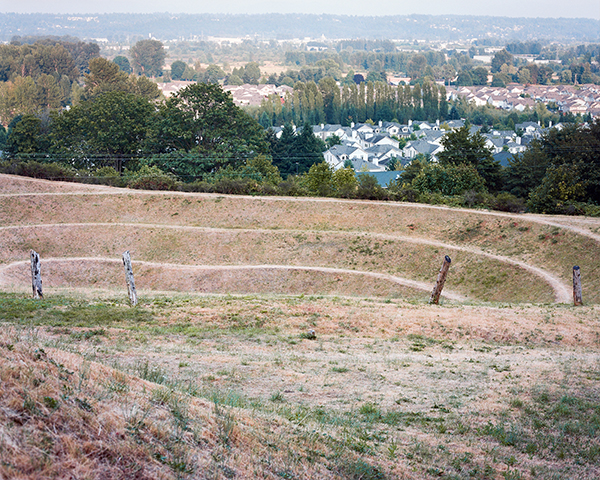
Robert Morris, Untitled (Johnson Pit No. 30), SeaTac, Washington. Photo: Molly Landreth, courtesy the Cultural Landscape Foundation.
Untitled (Johnson Pit No. 30), Robert Morris, SeaTac, Washington
Formerly an abandoned gravel pit donated by the department of public work to Kings County, Washington, Untitled (Johnson Pit No. 30) was the winning proposal selected from a 1978 symposium hosted by the King County Arts Commission. Earthworks: Land Reclamation asked artists to come up with new uses for “technologically abused land” in the county. Robert Morris reclaimed the site, planting a series of concentric circles of rye grass along the slopes descending into the pit. Since the work was completed in November 1979, illegal dumping, vandalism, lack of funding, and nearby residential development have threatened its continued existence.

Athena Tacha, Green Acres, Trenton, New Jersey. Photo: Aislinn Weidele, courtesy the Cultural Landscape Foundation.
Extant body of public commissions, Athena Tacha, various locations in the US
Some of the country’s earliest site-specific environmental sculptures are the work of Greek-American artist Athena Tacha. Since 1971, Tacha has completed 37 commissioned works of outdoor sculptures made of materials such as stone, brick, steel, water, plantings, and L.E.D. lighting. Today, only 30 of her works survive, and the threats to her remaining works include lack of maintenance, alterations, and even demolition. Particularly at risk is Green Acres, Tacha’s 1985 Trenton installation for the New Jersey State Department of Environmental Protection.
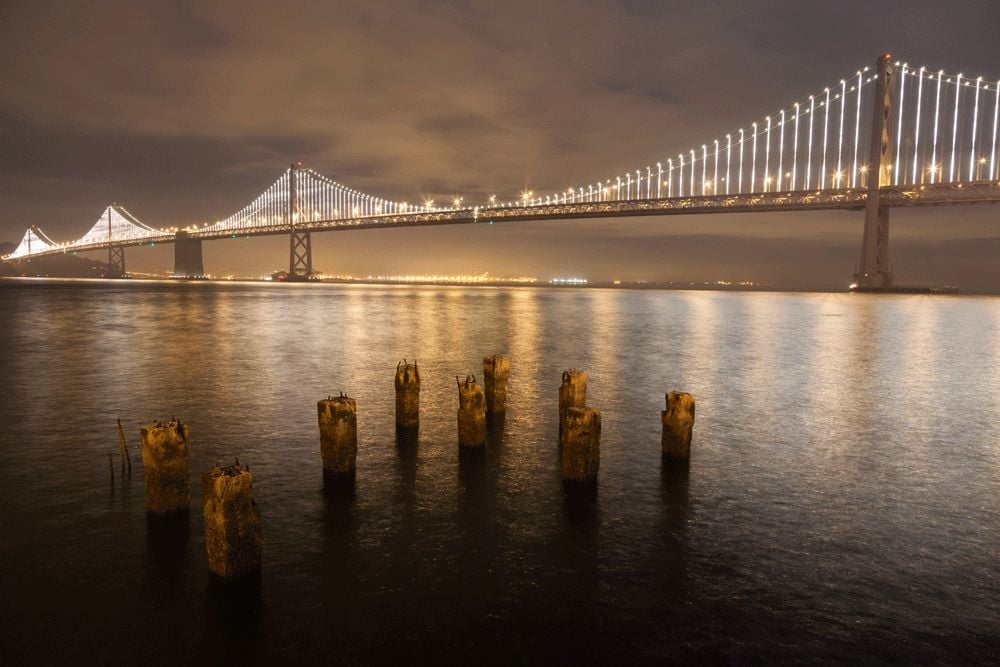
Leo Villareal, The Bay Lights (2013), on the San Francisco Oakland Bay Bridge at night with reflections in the water during an early test of the artwork. Photo by Almonroth, Creative Commons Attribution-Share Alike 3.0 Unported license.
Bay Lights, Leo Villareal, San Francisco, California
New York-based artist Leo Villareal’s monumental light project on San Francisco’s Bay Bridge may have only opened in March 2013, but maintaining the world’s largest L.E.D. sculpture—25,000 white bulbs along a 1.8-mile, 500-foot-high bridge—is no easy task. The initial development and installation, which was privately funded, cost $8 million. The computer-controlled display of ever-shimmering lights was intended to last two years, until next March, when they will be dimmed to accommodate previously scheduled maintenance. Keep ‘Em Lit through 2026, a crowd-funding campaign turn the lights back on afterward, is currently underway to fund the popular project’s long-term existence (see “Crowd-Funding to Keep Leo Villareal’s Bay Lights On“).
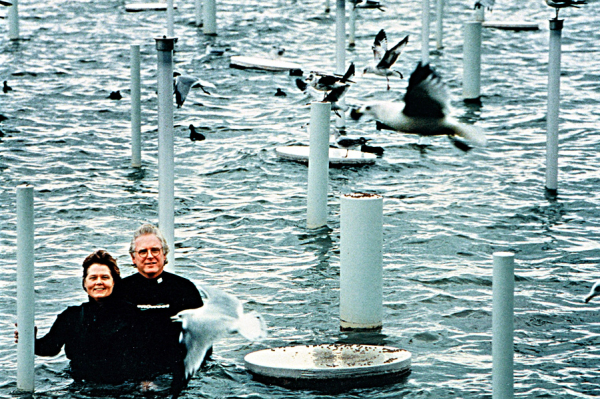
Frances Bagley and Tom Orr with their Dallas public art installation, White Rock Lake Wildlife Water Theater (2001).
White Rock Lake Wildlife Water Theater, Frances Bagley and Tom Orr, Dallas
First installed on the water in White Rock Lake Park in 2001 as part of Dallas’s Percent for Art program, Tom Orr and Frances Bagley’s popular public artwork Wildlife Water Theater has since fallen into disrepair. (The city cut funding for maintaining public art in 2009). Intended as a stage to showcase local birds, fish, and turtles, many of the work’s solar-powered polycarbonate poles no longer light up, and the city has proposed deaccessioning and destroying the piece. Since artnet News first reported on the story in March (see “Dallas to Remove Public Art Rather Than Pay to Maintain It“), there has been widespread public outcry, and a series of public meetings have been held on the issue.